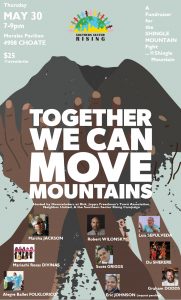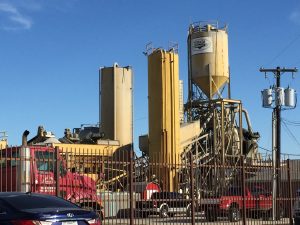Downwinders at Risk
Downwinders Chair is one of D’s 78 Women Making Dallas Great
D Magazine selected “78 Women Who Make Dallas Great” to profile in its September issue. Proud to say 26-year old Downwinders at Risk Chair Evelyn Mayo is one of them.

Meet the new Downwinders at Risk

Dallas Morning News Consumer Watchdog columnist Dave Lieber found himself listening in on the annual “State of the Air” presentation we’re always invited to give at the Arlington Conservation Council. Lots of information about smog and PM pollution but what really got his attention was the description in the Q&A about the wholesale transformation of Downwinders’ mission and board since 2017. He was so impressed he decided to write about it for his next column. Here’s the flattering result with some great pics our Chair Evelyn Mayo, our founder Sue Pope and (almost) our complete board as of August 2021. Thanks to Dave for the coverage and to all of you for supporting us through this transition.
For those without a DMN subscription we’re reprinting the entire article below:
Top anti-pollution group gets a makeover to an all-women board with young adults and people of color
Most nonprofit boards can only dream of bringing in younger members and people of color to reflect their communities. This one did it.
The phrase “trophy wall” caught my attention.
Jim Schermbeck, the wise old battler against Dallas-Fort Worth air pollution for the last quarter century, was bragging about his group’s new generation of leadership and its new focus on protecting neighborhoods.
I was in a webinar listening to Schermbeck, program director for pollution fighter Downwinders at Risk, as he gave an overview of our air quality (it’s bad!) when the trophy wall thing perked me up. It had something to do with Dallas City Hall officials leaving their jobs. Forgive the gruesome image, but the symbolism was that their heads were hung up on a wall.
I turned up the volume on my computer so I could hear.
He told a story about how the city of Dallas in recent years had allowed two northern Dallas neighborhoods to create their own land use plans. But when two southern Dallas neighborhoods tried to do the same, they were told by the city that neighborhood-based land use plans created by community members were no longer acceptable.
Putting it bluntly, white neighborhoods were allowed to create bottom-up plans that were presented to and accepted by city officials. But these neighborhoods where people of color live were forced to accept top-down plans imposed upon them by City Hall.
Schermbeck mentioned the group’s chair, Evelyn Mayo, a 26-year-old firebrand, and said, “This made her mad.”
Mayo helped organize several groups into the Coalition for Neighborhood Self-Determination, which agitated for fairness in community-created land use plans. Letters were sent to Dallas Mayor Eric Johnson, the City Council and City Manager T.C. Broadnax.
/cloudfront-us-east-1.images.arcpublishing.com/dmn/VHF2H4PGCBFPHDLIWRBDDDUSFU.jpg)
The power play appears to have worked. Three zoning officials decided to retire from the city. They are: Peer Chacko, the city’s director of planning and urban design; David Cossum, development services administrator; and assistant zoning director Neva Dean.
Kris Sweckard, the director of sustainable development and construction, was reassigned to the city’s aviation department on an interim basis.
“So at age 26, this woman has a department head on her trophy wall for a good cause,” Schermbeck was saying. “It’s just amazing to watch. If you ever think young people are not with it, and you want to build your confidence back up about people, please come to a board meeting or hang out with Evelyn and her friends for a while. They will restore your confidence about where we’re headed. She’s an amazing person, and our board is really great.”
/cloudfront-us-east-1.images.arcpublishing.com/dmn/A2SOKXOTI5HBBAGB6CVHNDCLJA.jpg)
Shine a spotlight
I asked Mayo how she felt about the trophy wall analogy. “I don’t think it’s something you should aspire to,” she said. “We were simply reacting to circumstances presented before us.”
Later, she toughened it up a bit, saying: “Whether it’s a trophy wall or not, what’s happening at City Hall is a product of their own incompetence.”
Downwinders board member Misti O’Quinn told me that the coalition shined a spotlight on one portion of neighborhood zoning, and when you shine a spotlight you can expose. What does that mean for city officials? “You take away their sense of security,” she said.
/cloudfront-us-east-1.images.arcpublishing.com/dmn/XOB66IBJRFCCPDQFPUCP7KZPLA.jpg)
I attempted to reach the four City Hall officials but was unsuccessful. When I ran this scenario up the flagpole to Broadnax, he provided a written statement to The Watchdog explaining that when several staffers announced their intention to retire this year, it presented an opportunity to realign their departments.
“Over the next several months,” he said, “we intend to simultaneously restructure permitting and planning and realign the departments and leadership that oversee them. Reorganizing these departments will maximize effectiveness and productivity.”
He made no mention of the coalition or its agitation.
Change with the times
This story runs far deeper than citizen agitation. Downwinders represents a model for how environmental and other nonprofits can alter their profile, their mission and their leadership.
As I looked at the group’s history, I saw how Downwinders has changed in recent years.
Formed in 1994 by Midlothian rancher Sue Pope and other rural residents and suburbanites, Downwinders’ mission for the longest time was fighting pollution caused by cement plants.
/cloudfront-us-east-1.images.arcpublishing.com/dmn/YOOOOF4INFGW5JU7KCBDVI6NUQ.JPG)
But by 2017, the year Mayo joined the board, it was becoming clear — thanks in part to the hideous Shingle Mountain dump site in southeast Oak Cliff — that Dallas needed a spotlight to focus on what activists and academics call historically racist zoning. That’s what allows dirty industries into poorer residential neighborhoods where people of color live. Correcting those inequities is called environmental justice.
In the next two years, the old guard board members, many of whom had served since the group’s creation, all dropped off. The board and its mission changed from rural/suburban to urban.
“It was very traumatic,” Schermbeck recalls. “But I’m so glad we did it because we’re more plugged in than ever before.”
Mayo says the worst moment came in 2019 when she was elected to the unpaid job of chair in what she calls “a somewhat contentious vote.”
The board is now all women; two are Asian-American, five are Black, two are Latina and three are white. Three members are in their 20s, and six are in their 30s. One member is 17 years old.
Most community nonprofits, especially in the traditional environmental arena, can only dream of putting together a board with that diversity.
Mayo, who teaches at Paul Quinn College, has a perfect resume for her leadership role. She majored in environmental science in college with a focus on race and ethnicity.
Working as a paralegal at Legal Aid of NorthWest Texas, she co-authored a study called “In Plain Sight,” which examined the governmental failures that allowed a disaster like Shingle Mountain to spiral out of control.
Then while teaching undergraduates at Paul Quinn, she and her students in 2020 completed a study – “Poisoned by Zip Code: An Assessment of Dallas’ Air Pollution Burden by Neighborhood.” You can guess the results of that survey.
The Downwinders’ main goal, in addition to continuing its legacy battle against dirty air, is to bring power and expertise to the city’s poorer neighborhoods that have had no say in dirty industries moving in.
/cloudfront-us-east-1.images.arcpublishing.com/dmn/3VRLM7INOFGSHGAAN667IY3NYI.jpg)
“The legacy of racist zoning perpetuates unless you fundamentally redraw the map through these land use plans,” she says. “People who are affected must be involved in the decision-making process about what their neighborhood will look like. This will probably have better outcomes for their health and wellness.”
Yet, she adds, “People who live there and bear the brunt of the pollution are still not at the decision-making table.”
Mayo says her group needs all the help it can get.
“No matter who you are, we can put you to work if you’re interested and willing,” she says.
Note: A tip of The Watchdog’s hat to Downwinders’ board members: Cressanda Allen; Satavia Hopkins; Misti O’Quinn; Essence Tetteh; Marsha Jackson; Cindy Hua; Amber Wang; Idania Carranza; Soraya Coli; Amanda Poland; Michelle McAdam; and Shannon Vorpahl.
A BIG THANK YOU
You Contributed Over $21,000 for Our
COVID-Connected Program Work Last Week

In our first ever attempt to conduct a week-long fundraising campaign, much less during an unprecedented pandemic, we had unprecedented success. Over seven days our supporters contributed a total of $21,600 to Dowwinders at Risk. That’s the most we’ve ever raised during one of our fundraising drives.
Besides raising needed funding for our work, we also received national exposure through the Peace Development Fund’s Grassroots Fundraising Week that featured us and 12 other grassroots groups doing social justice work around the country during the COVID crisis.
These new funds will be used to support our zoning equity work surrounding he upcoming “forwardDallas! land use planning process, the new regional air monitoring network we’re building, assistance to grassroots groups such as Southern Sector Rising, and continued original reporting of local environmental news.
We can’t tell you how much we appreciate the contributions, especially in light of the circumstances. We value your support and pledge to squeeze every bit of change out of every dollar you send us. Thank you.

DIRECTOR

CHAIR
Downwinders Welcomes New Board Members
November brought a round of new board members joining our ranks. It also brought an historic milestone. For the first time in our 25 year history, we’re now governed by a board whose majority is composed of people of color.
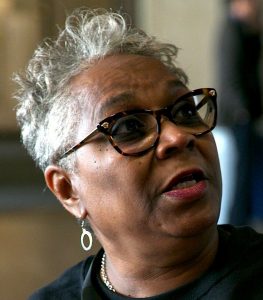 Marsha Jackson
Marsha Jackson
A year ago not many people at Dallas City Hall knew Marsha Jackson’s name. That’s not the case this December. Ms. Jackson is both the founder of her own neighborhood group, Neighbors United, and the citywide Southern Sector Rising Campaign for Environmental Justice. She’s also the nearest neighbor to Shingle Mountain, Dallas’ largest illegal dump and the highest profile symbol of environmental racism in North Texas since the RSR lead smelter clean-up in the early 1990’s. Like Luis Sepulveda almost 30 years ago Marsha Jackson’s name has become synonymous with the fight for Environmental Justice in Dallas.
Michelle McAdam
Michelle is a long-time friend of Downwinders who finally decided to join the board. She was a student in the very first year of our College of Constructive Hell-Raising, where she met her unlikely Southern Dallas doppelganger and provided us with one of our favorite college stories. She’s a true Daughter of Dallas nobility but instead of resting on our laurels or trust funds, she’s worked tirelessly her whole adult life for people who haven’t been as fortunate, including being on staff at the International Rescue Committee and now as an Economic Empowerment Specialist at New Friends New Life, a group working to transition women out sex trafficking or exploitation.
 Justina Walford
Justina Walford
Justina is a former District 4 City Council candidate, Southern Dallas dog rescuer and advocate, and member of the Southern Sector Rising Campaign Steering Committee. She’s also Director of the annual Women Texas Film Festival. Born and raised in Southern California, Justina owned a theater in Hollywood during the early 2000’s where she produced full length plays and storytelling events that included her original work.
Amber W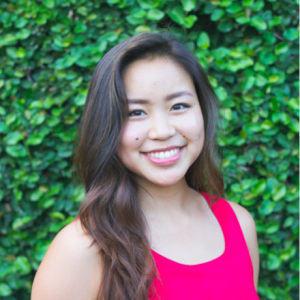 ang
ang
Amber has degrees from Rice in Mechanical Engineering and trouble-making from our own College of Constructive Hell-Raising. She’s Technology Manager at the Victory
Co-Working space Hatchways and has bravely decided to help us in developing more sustainable local funding source. At Rice Amber led a student design organization that developed pro bono solutions for nonprofit organizations and social ventures in the Houston community. We hope she can do the the same for us.
SHINGLE MOUNTAIN FUNDRAISER MAY 30th
THANKS!
You generated over 60 letters of opposition to the Bird Lane Batch Plant
Zoning Vote for Bird Lane Batch Plant Pulled from December 13th Plan Commission Agenda
Individual Hearing Scheduled
Thursday January 17th, 1:30 pm
Dallas City Hall Rm 5ES
Speak Out Against Environmental Racism
The first of two Estrada Concrete batch plants proposed for right around the corner from Blue Star Asphalt Recycling and initially slated to be routinely approved as part of a group of more mundane zoning requests, is now scheduled for its own hearing and vote next month.
Thanks to neighborhood opposition, including, God Bless Them, Temeckia Dorrough and Marsha Jackson plus the Inclusive Communities Project, institutional opposition from near-by Paul Quinn College, and over 60 letters generated through the Downwinders’ Click N Send feature, the Plan Commission pulled the batch plant form its consent agenda on December 13th and scheduled a separate hearing and vote on the case for January 17th.
Had vigilant citizens not plugged-up the City Hall pipeline, this is a zoning change that would have passed easily with full staff support and without even a record vote by the Commission.
At stake is issuance of a Special Use Permit, or SUP, the owners need to operate a concrete batch plant on the Bird Lane property for a minimum of three years.
Still unknown is when the OTHER Estrada Concrete batch plant also gets the green light for a scheduled vote. It’s proposed for Zonie Road, immediately adjacent to and downwind of homes and a shingle’s throw from troubled Blue Star Asphalt Recycling. It’s possible both sites could be on the same January 17th Plan Commission agenda.
The Bird Lane site is already zoned Industrial Research (IR) while the Zone Road site is zoned Agricultural with a pending request to zone it Industrial Research as well. IR and Industrial Manufacturing, or IM zoning next to minority residential neighborhoods along the Trinity River has been the source of most local environmental justice battles.
Opposition is based both on the specific problems the batch plants would cause for neighbors, and the fact that this part of South Dallas already has a disproportional amount of polluting industries.
Come January we’ll be adjusting our Click N Send messaging to reflect the new Plan Commission hearing and vote date and let you know when you can have another big impact with your letters of opposition.
Discussion of both these proposed batch plants and the underlying zoning issue which keeps facilities like this coming to South Dallas will be on the agenda at the next “Let Joppa Breathe” Alliance meeting, scheduled for January 14th.
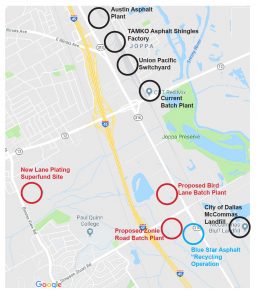
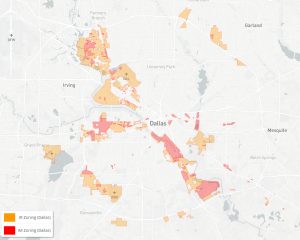
Al Armendariz, Graham Dodds, and Brett Shipp Take an Electric Bus to a Bar: 2019 Root and Branch Preview
Every year Downwinders at Risk takes a week off and sponsors a floating conference aimed at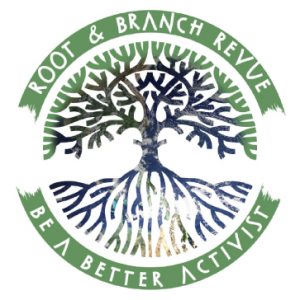 making North Texas organizers and activists better advocates.
making North Texas organizers and activists better advocates.
This year’s Root and Branch Revue is again packed with star power and covers new ground. Here’s your first preview of what’s being offered.
Mark you calendars now. These events are for people exactly like you.
Wednesday/December 5th
Why Does Green Look So White in DFW?
A Discussion from the South Side of the River
7 to 9 pm
African American Museum in Fair Park Dallas
FREE
Featuring:
Al Armendariz, Former EPA Regional Administrator
Cherelle Blazer, Sierra Club/Beyond Coal
Clarice Criss, Field Manager, Color of Change
…and others
Co-sponsor: Sierra Club/Beyond Coal
—————————————-
Thursday/December 6th
Electric Glide Bus Pub Crawl
How Electric Buses Can Save Profits, People, and the Planet
6-8:30 pm
Start: The Green Door in the Farmers Market Dallas
$25
Price Includes:
Custom Electric Glide Cocktails from The Green Door and Harwood Tavern
Pop-Up restaurant with food by Chef Graham Dodds
Presentation by E-bus manufacturer Proterra founder Don Hill
Co-sponsor: Climate 350
—————————————-
Saturday/December 8th
1-Day University of Change
A Full Day of Workshops to Help You Become a Better Advocate
10 am to 5:00 pm
GoodWork Co-Working Space 1808 S. Good Latimer Dallas
$25 Includes lunch and all these workshops….
“Mapping Injustice” with Robert “The Map” Mundinger
“Build Your Own Air Monitor” with Constant Marks
“Zoning 101” with Paul Cardin
“Investigative Research” with Brett Shipp
“Portable Air Monitor Training“ with the Downwinders PM Committee
“How to Stop a Batch Plant and Other ‘Standard’ Polluters” with David Frederick and Tamera Bounds
WITH MORE TO COME
Fresh from the Vault: Open Records Act Results from the Dallas Office of Environmental Quality
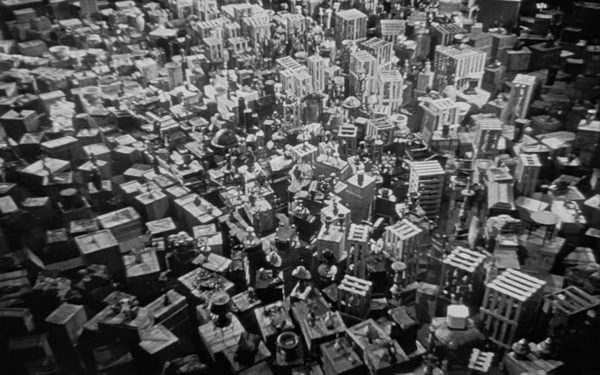
Last month we requested the City of Dallas’ Office of Environmental Quality files concerning air quality monitoring going back a few years. We wanted to know more about how City staff chose the Texas Nature Conservancy’s “Breathe Easy” study as its first air monitoring project through a process of…well, there wasn’t exactly a process was there?
Here’s some highlights from the materials we reviewed so far:
Despite criticism, OEQ Staff is recommending using the same air monitors for its own study that Downwinders used in Joppa.
OEQ staffers have criticized Downwinders’ portable monitoring in Joppa…despite the lack of any city monitoring up to that point in the neighborhood. Something about the lack of reliable data. But lo and behold, OEQ staffers seems to have recommended not only the same company (New Zealand-based Aeroqual) to the Nature Conservancy for its stationary monitors, but also exactly the same portable air monitors. We told you they were good.
Any local university scientist who’s worked with Downwinders is blackballed.
Dr. Kuruvilla John, Professor and Chair Department of Mechanical and Energy Engineering at the University of North Texas was “…biased because funded by Downwinders” according to one meeting summary and blackballed by OEQ staff as a City technical advisor for the Breathe Easy project. Dr. John’s sole sin was to get paid as a contractor in 2015 by Downwinders to perform a single study using the state’s own computer model for DFW smog. Before ruling him out, no one on OEQ staff mentioned that Dr. John’s modeling and study was endorsed by a unanimous Dallas city council vote recommending the EPA take more proactive measures to reduce smog pollution.
One wonders if his collaboration with Downwinders and other citizens groups in the DFW Air Research Consortium have made UTD’s Dr. David Lary similarly verboten to OEQ staff.
Dallas City staff in-kind contributions to the Texas Nature Conservancy “Breath Easy” project are very, very large.
To date, the partnership between the City and the Texas Nature Conservancy has raised almost $300,000 in grant money for a study involving nine schools. But that total pales in comparison to the in-kind contributions the city is making to the effort over both its developmental period and it two-year run. For example…
Combine all the staff time over 3-4 years with data services costs and you could well have a multi-million dollar donation from the City of Dallas to the Texas Nature Conservancy, courtesy of your tax dollars.
OEQ staff likes the idea of a new air monitoring network…in other cities.
As one OEQ staffer put it: “We’re looking at air monitoring programs in states and cities. In Minneapolis/St. Paul the state agency is installing low cost (and low resolution) monitors in every zip code. In L.A. they are installing 100 monitors citywide. Baltimore, Chicago and Lafayette all have enhanced monitoring programs. Here the TCEQ has zero interest in any of these projects. The EPA staff are very interested, but cannot offer any financial support.”
A OEQ staffer sought a job with the Conservancy even as the Breathe Easy project was taking shape.
“We are teaming up with the Nature Conservancy and their new Urban Conservation Director ( a position I interviewed for in early 2017….)”
As you piece together the email chains and date memos, it’s clear that if it weren’t for the considerable support from the City of Dallas, the Nature Conservancy’s Breathe Easy air monitoring project would…need a lot more grant money.
Why has OEQ staff committed so much time and money to a two-year study of nine schools while dismissing the lesser expense and effort of joining a regional network of air monitors many times that size? A real time air quality network modeled on the very kind OEQ staff seem to admire from afar in other cities? That’s an answer that we haven’t found in the files yet.
But it’s something to keep in mind for the re-scheduled September 24th Quality of Life Committee meeting where presentations about both the TNC/City’s private study and the DFW Air Research Consortium public network will be featured.
Dallas’ Office Of Environmental Quality: “You Can’t Handle the Truth” about Pollution

MONDAY, AUGUST 27th
9 AM
ROOM 6ES
DALLAS CITY HALL
CITY COUNCIL QUALITY OF LIFE COMMITTEE HEARING ON DALLAS JOINING A NEW REGIONAL AIR NETWORK
______________________________________________
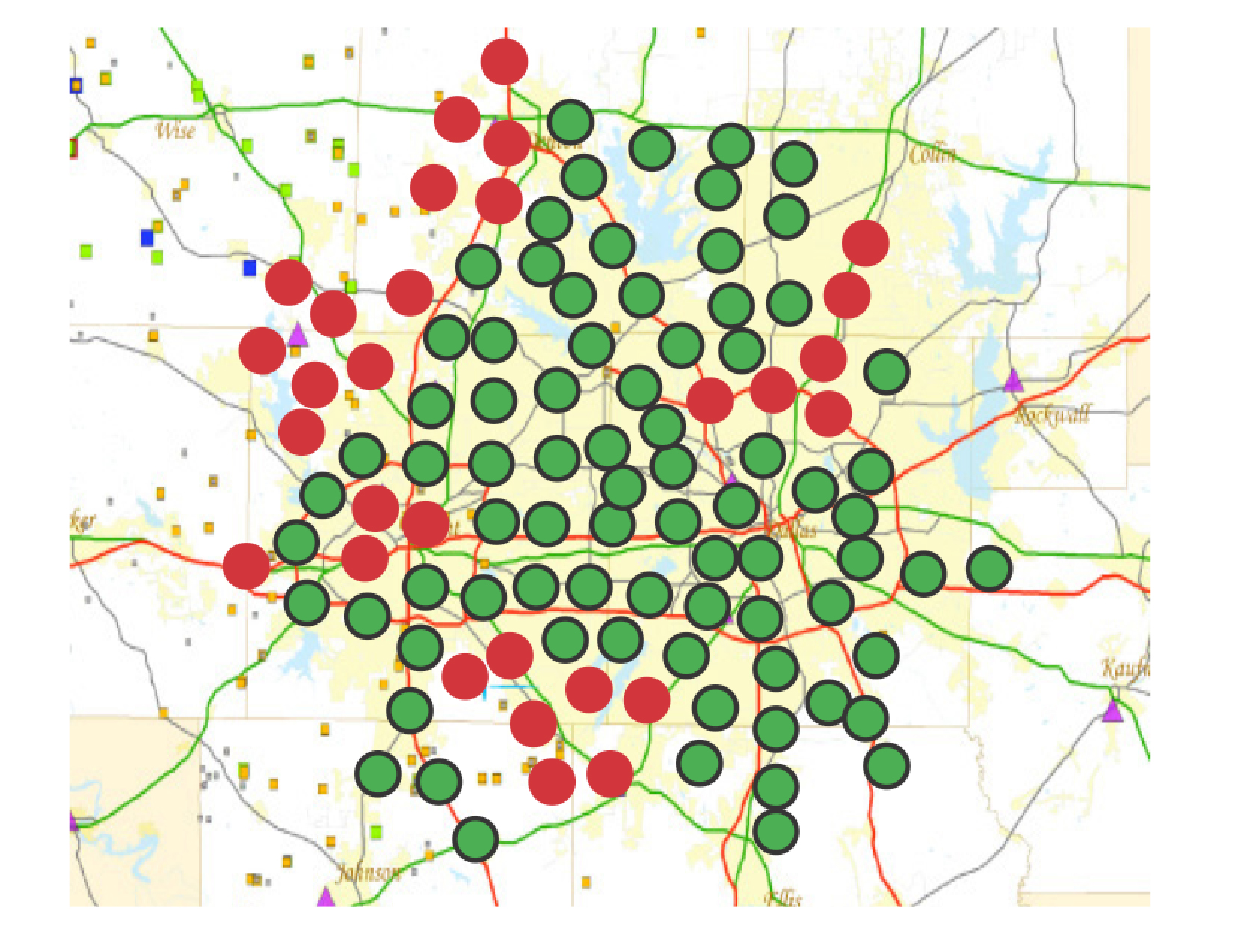 Over the last two years, as members of the DFW Air Research Consortium have promoted the idea of a dense grid of low-cost, high-tech air sensors spread across North Texas, their audiences have usually had one universal response: “This is great. It’s a no-brainer. When can we start? “
Over the last two years, as members of the DFW Air Research Consortium have promoted the idea of a dense grid of low-cost, high-tech air sensors spread across North Texas, their audiences have usually had one universal response: “This is great. It’s a no-brainer. When can we start? “
The single exception to this excitement is the City of Dallas Office of Environmental Quality.
Strange isn’t it? That hotbed of radical environmentalism known as Plano is embracing the idea of network air monitoring with both arms. Richardson and Fort Worth are interested as well.
But within Dallas City Hall there’s not only skepticism, but out right hostility to the the “smart city” idea of providing real time air quality information to citizens from hundreds of monitors.
Why?
On more than one occasion OEQ staff has said that they don’t want to have to take calls from Dallas residents who notice high air pollution levels in their neighborhoods and…expressed the opinion that “certain groups won’t responsibly use the information produced…like in Joppa.”
In other words, the public can’t handle the truth.
(Remind us again what happened in Joppa?

Oh yeah, Dallas OEQ staff was in favor of putting two additional dusty dirty batch plants in the small Freedman’s community that already has a large and polluting roofing shingles plant, a batch plant, and a huge rail switch yard surrounding it.
They made their recommendation for two more batch plants without doing any kind of air monitoring at all in Joppa, despite months of residents testifying at various hearings and meetings about the pollution problem and despite OEQ having the equipment to do it.
Staff made their recommendation without comparing the pollution in Joppa to other Dallas neighborhoods, or without examining any kinds of equity issues at all. Is Joppa the victim of Environmental Racism or not? The OEQ was silent.
Staff based their support solely on the lack of complaints – a record rendered invalid by plenty of Joppa community meetings where air pollution was complained about – and the moderate levels of pollution recorded by the single EPA-TCEQ PM monitor in all of Dallas County, located some nine miles away from Joppa near Mockingbird.
When Downwinders showed up a week before the Council vote and actually took air samples in Joppa for the first time, they showed levels of Particulate Matter that were much higher than that EPA monitor, demonstrating how ridiculous it was for OEQ to base its assurance to Joppa residents on it. It made them look like they hadn’t been doing their job. And they hadn’t. And they hadn’t done it in West Dallas with the concrete storage silo and batch plant fights there. Lately, OEQ hasn’t met a polluter it didn’t like.)
So instead of endorsing the idea that the public has as much of a Right-to-Know what’s in their air as in their food, OEQ would just rather you just not know. Ignorance is bliss.
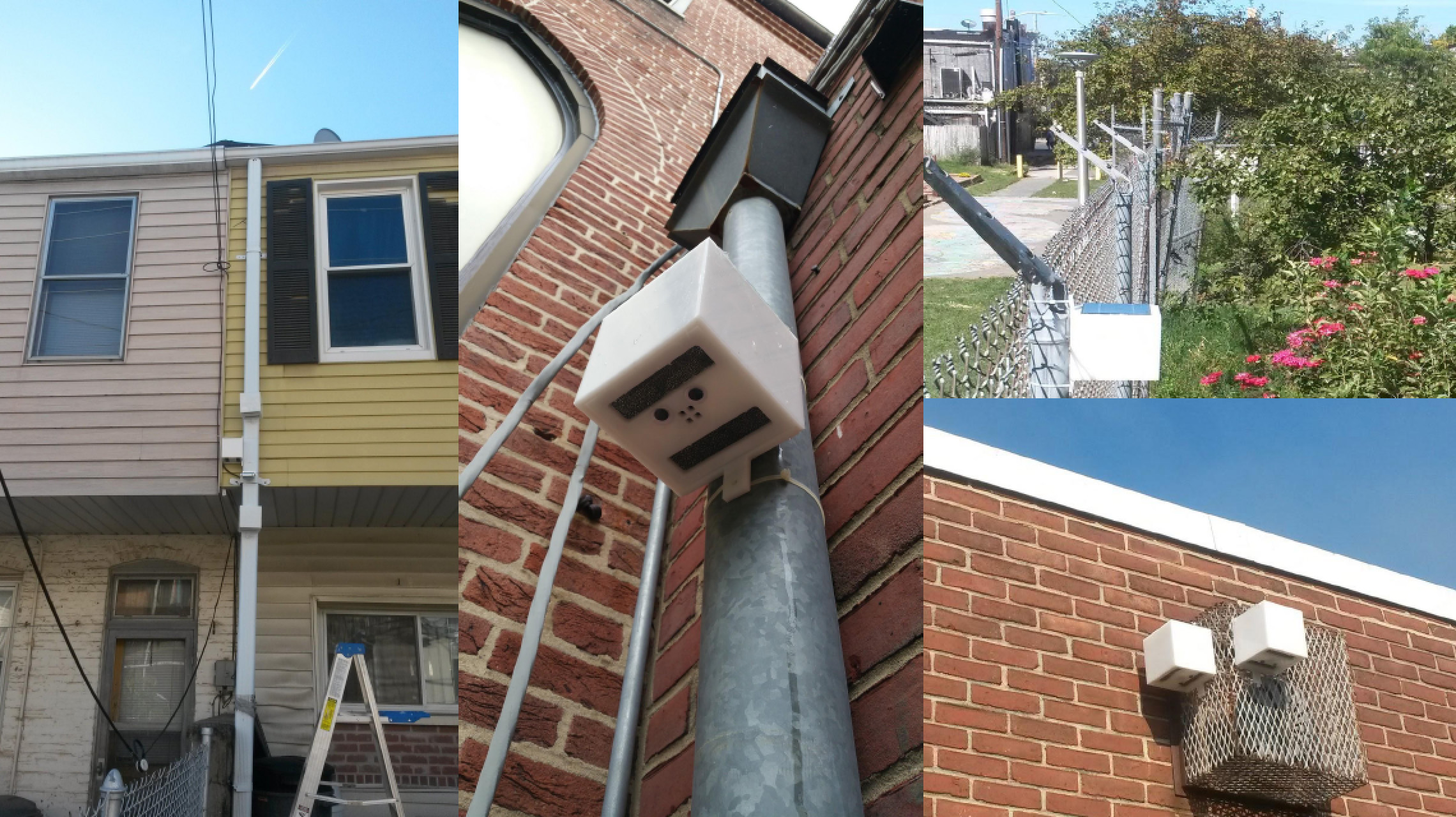 OEQ staffers also have said they object to a network of new air monitors because EPA doesn’t yet recognize their data as “official” and so it can’t be used for enforcement…yet. But do these air monitors have to have that official recognition to begin doing lots of good things for public health?
OEQ staffers also have said they object to a network of new air monitors because EPA doesn’t yet recognize their data as “official” and so it can’t be used for enforcement…yet. But do these air monitors have to have that official recognition to begin doing lots of good things for public health?
Joppa residents didn’t need EPA certification to compare the levels Downwinders recorded with the “official monitor” and know something was wrong. Doctors say they don’t need it to begin looking at correlations between area pollution levels and heart attacks, strokes ER visits, and school absenteeism. Cyclists and runners say they don’t need EPA certification to plot the least-polluted routes for exercising according to the grid. Cities like Plano says it doesn’t need it to better time traffic lights and reduce pollution that way.
It’s quite possible just knowing there are new monitors out there relaying real time information will now make a plant manager think twice about doing something questionable on a weekend or holiday. That’s enforcement – without EPA certification.
Given that Dallas currently doesn’t quantify or measure Environmental Justice issues in the city limits, a monitor network could provide planners and City Council members with a tool to do just that. It could graphically demonstrate how some Dallas neighborhoods are burdened with a lot more air polluters than others, and draw a map of those inequities to prevent them being made worse….to prevent mistakes like the OEQ staff was making in Joppa. You don’t need EPA certification for that impact either.

The hollowness of these staff arguments is proven by OEQ’s own actions. Even while it dismisses the unruly democracy of a real time broad-based PUBLIC monitor network, it’s committing over a million dollars of in-kind staff time and City resources to assisting a PRIVATE air monitoring study that is supposed to show how health can be improved….without EPA certification of the monitors being used.
So the same argument that city staff is using to dismiss the public network is the same one it’s using to support the private study.
You might recognize this M.O. at City Hall:
Staff decides it absolutely must do something about something. It decides how to accomplish that something after an exhaustive and rigorous search of talent and resources within a 100 foot radius of the office where that something is decided. An all out effort is then made to bias, slant, tilt, and otherwise favor the approach staff has decided must be taken against all other alternative approaches that might make sense outside of the 100-foot office radius. Nothing but the original staff approach is worthy of consideration, all others being the work of Satan or Dirty Hippies.
And the City Council? The Deciders for the public-at-large? They have an option to get involved at the very end of this sausage-making. Staff’s view seems to be that bliss is ignorance here too.
This happened with the Trinity River. Now it’s happening with air quality.
In 2014 Dallas got some Rockefeller Foundation money for “Resilience“ preparation. For those without a program, resilience is the fancy Rockefeller Foundation word for Climate Change, or rather the symptoms of climate change. Elected officials and bureaucrats are supposed to feel safer about using it.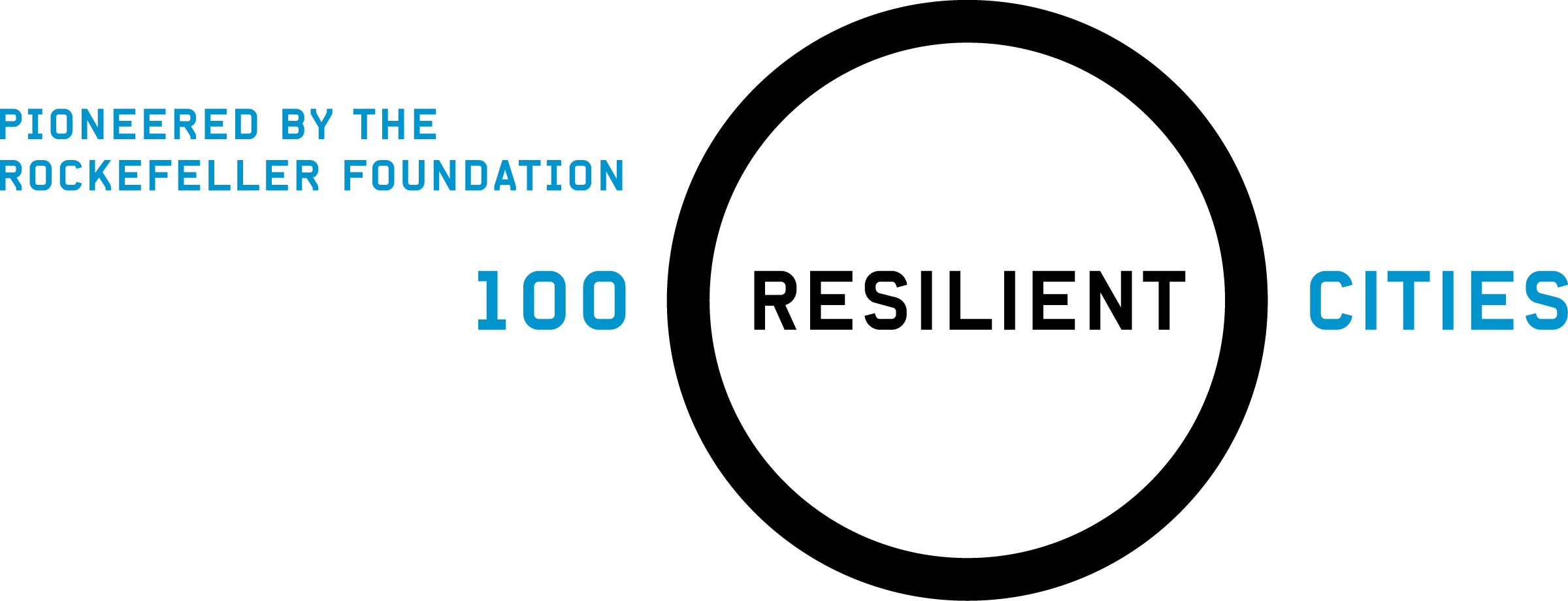
Dallas got so much money that the City created an Office of Resiliency. And that office sponsored invitation-only forums on how Dallas could be more resilient. Not open forums mind you. Not public hearings. They wanted the folks they’d located through that rigorous and exhaustive vetting process. None of the Satanists or Dirty Hippies got notice.
One of the right kind of groups that did get invited to those forums was the Texas Nature Conservancy, a mostly wealthy and white group of landowners dedicated to the noble idea of putting aside large tracts of undeveloped land for permanent preservation. It’s a group well-known for its dedication to open spaces – but not for any research it’s ever done on air quality.
Nevertheless, out of these forums suddenly emerged a partnership between the City of Dallas and The Nature Conservancy to do some kind of new air quality monitoring. There was no competition of concepts and no decision by the City Council. Staff had decided, and that was that.
And so you get the “Breathe Easy” Study.
Nine (as yet unspecified) DISD schools in “South Dallas” will be wired with new air monitors recording Ozone and Particulate Matter pollution in real time over one or two years to study the impact of anti-pollution measures like stricter idling policies on school absenteeism rates.
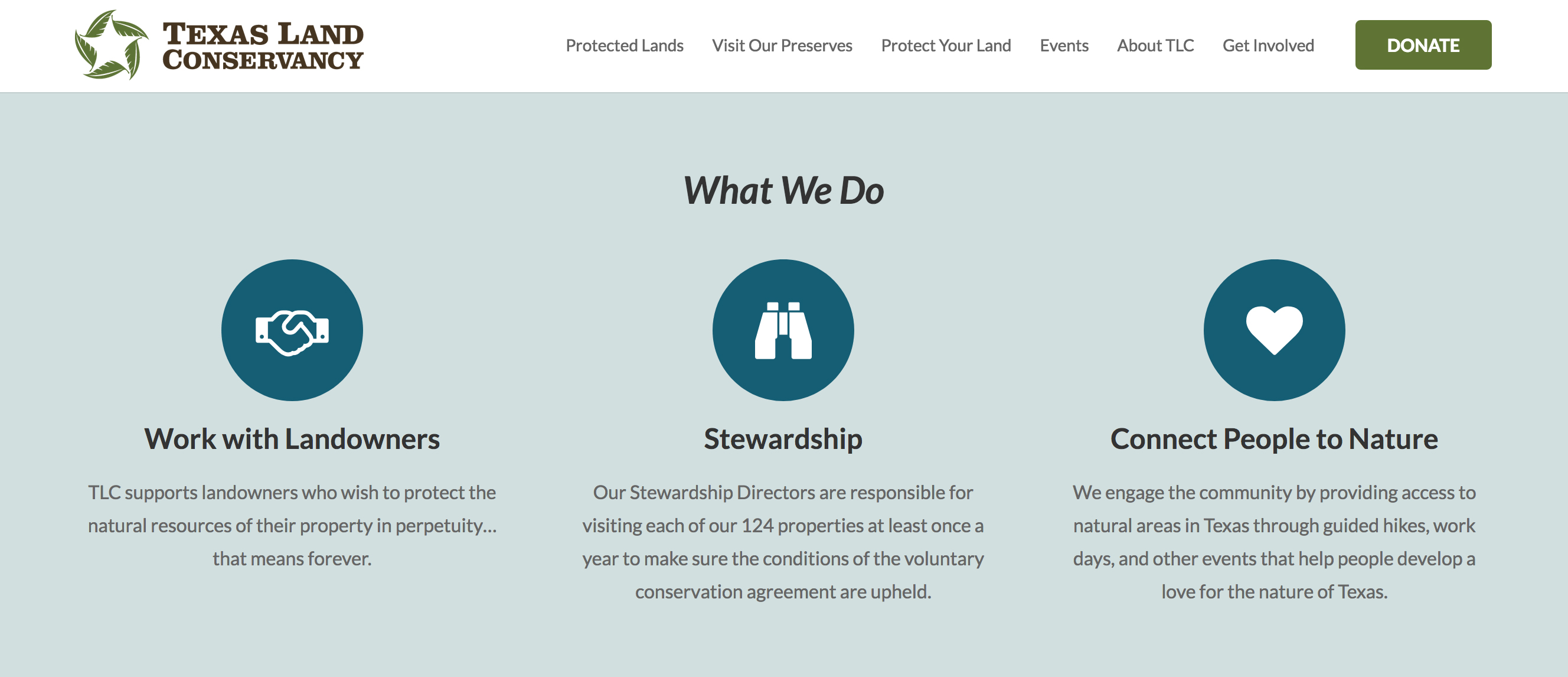 But while the information will be gathered in real time from these nine schools, that information will not be shared with the public on the City of Dallas website until after (an as yet unspecified) time has passed. No annoying calls from pesky citizens (or parents) asking why their neighborhood’s air pollution levels are so high today.
But while the information will be gathered in real time from these nine schools, that information will not be shared with the public on the City of Dallas website until after (an as yet unspecified) time has passed. No annoying calls from pesky citizens (or parents) asking why their neighborhood’s air pollution levels are so high today.
Furthermore, after the study is completed it’s unclear what’s going to happen to the monitors in the nine schools.
In this case, the Conservancy and City seem to be tracking the “resiliency” of Dallas students in the face of chronic and acute air pollution problems, and then letting them know after the fact how resilient they were.
And is it irony, cynicism, or both when Dallas City Hall says this new study is needed because “Black kids in Dallas have an asthma rate eight times higher than Asian children and four times higher than whites.”
Maybe that’s because the Dallas OEQ keeps approving batch plants in their neighborhoods.
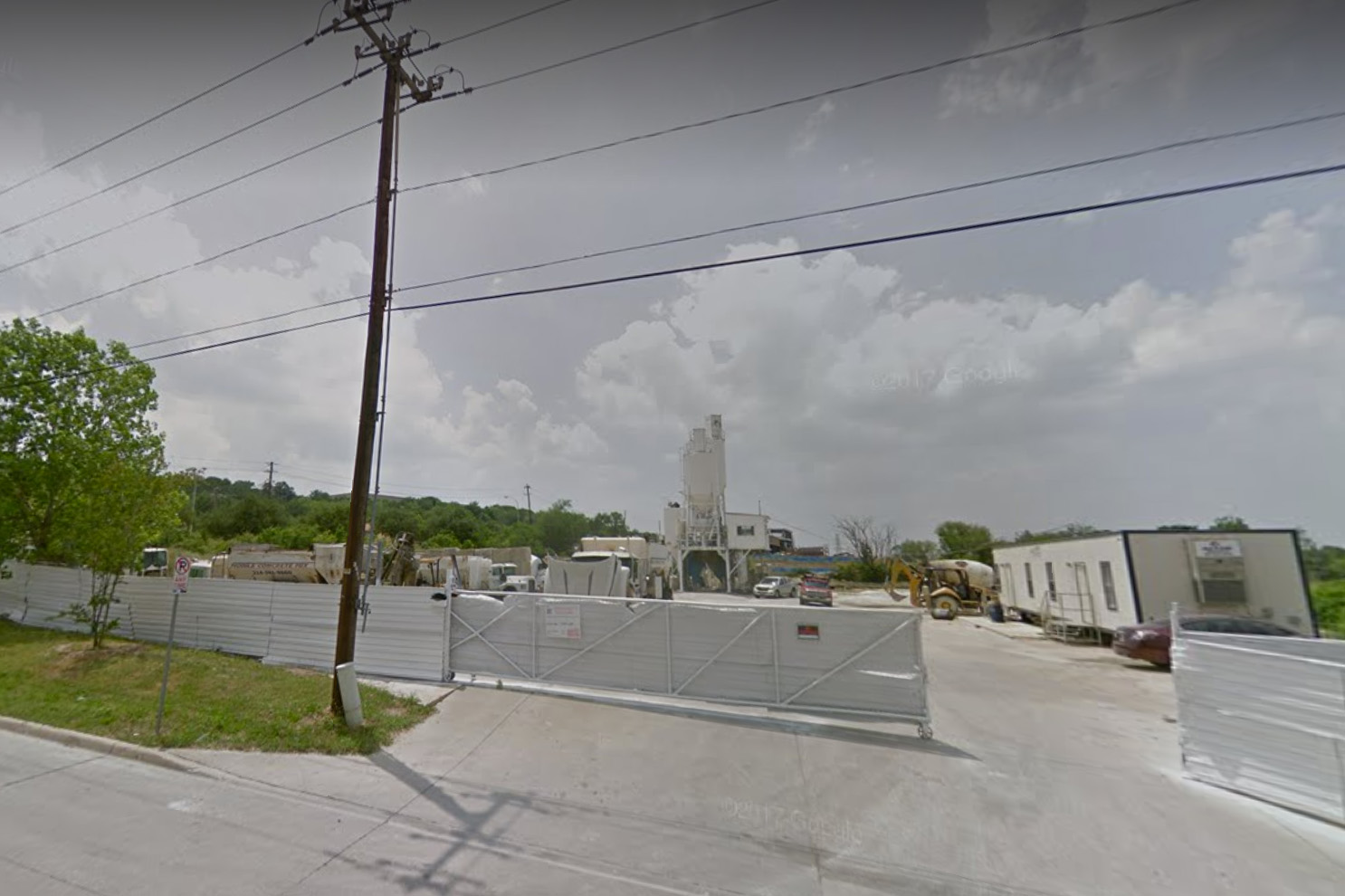 The same department which approved the relocation of the Argos batch plant from gentrified Trinity Groves to working class West Dallas, approved Buzzi’s 165-foot tall concrete silo next door, approved the RamCrete batch plant permit down the street, and whole-heartedly approved two new batch plant permits in Joppa IS NOW concerned about Environmental Justice issues! What amazing powers that Rockefeller money has.
The same department which approved the relocation of the Argos batch plant from gentrified Trinity Groves to working class West Dallas, approved Buzzi’s 165-foot tall concrete silo next door, approved the RamCrete batch plant permit down the street, and whole-heartedly approved two new batch plant permits in Joppa IS NOW concerned about Environmental Justice issues! What amazing powers that Rockefeller money has.
So far, TNC reports they’ve received almost $280,000 in grant money for support of this study. Paperwork found as part of a Texas Open Records Act Request Downwinders submitted to City Hall suggest the City is donating a million dollars in data services capacity alone. That’s in addition to the considerable staff time also lent to the effort. In-kind donations from DISD have not been disclosed.
We know that reducing kids’ exposure to PM pollution will help their health and well-being. We know one way to do that is by turning off vehicle exhaust. It’s not clear what kind of return the TNC or City is getting for its considerable investment.
Meanwhile, the idea of a new network of low-cost, high-tech monitors throughout North Texas giving the public real time information about the state of the air its breathing actually sounds like a great Rockefeller resiliency grant because it helps individuals and localities deal with the symptoms of climate change in their daily lives.
Moreover it’s an indigenous, grassroots effort.
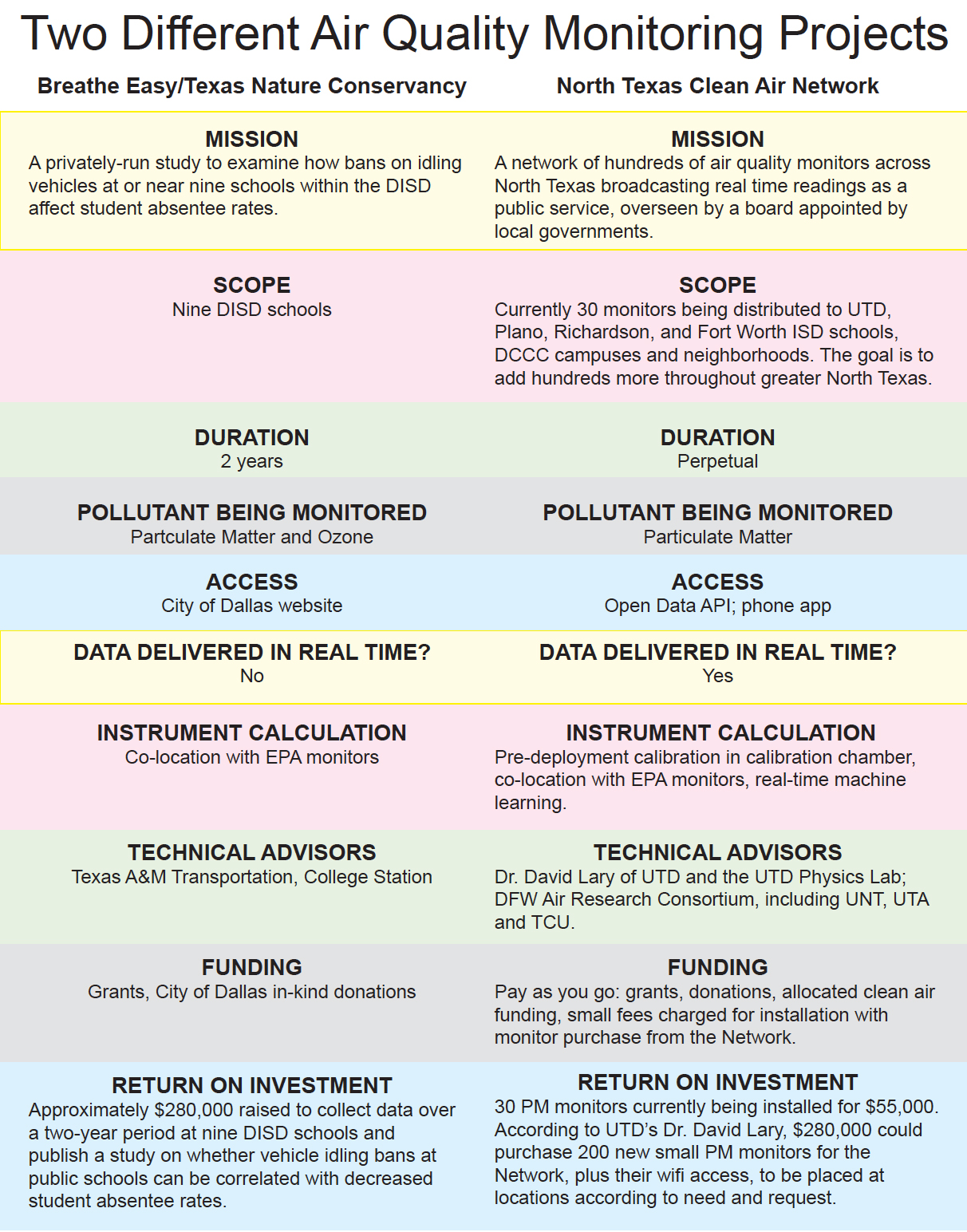
Because the rigorous and exhaustive vetting at City Hall didn’t make it the long 17 miles up to UTD, staff had no idea that one of the nation’s premiere experts in air monitoring teaches there. Oxford-trained Dr. David Lary just got a huge contract from the U.S. armed forces to help them better equip our soldiers for fighting in hostile and toxic urban environments. A big selling point was all the different air toxins in DFW standing in for the real thing. Honest.
It was Dr. Lary’s 2016 National Science Foundation proposal for a pilot project that got the regional network ball rolling. Even though it didn’t get funded, it brought together local governments, scientists, and citizens groups who then forged their own regional slow-cook version. Representatives from UNT, UTA, TCU, and UNT’s Health Science Center participated. So did Plano, and Dallas County.
Dr. Lary has outlined a monitoring network that’s capable of correcting itself in real time using those EPA official monitors as a baseline. EPA has said they’re interested in using his approach. So has NASA. He’s the foremost authority on this topic within hundreds and hundreds of miles but somehow, but Dallas city staff never found him because he wasn’t on that exclusive invite list.
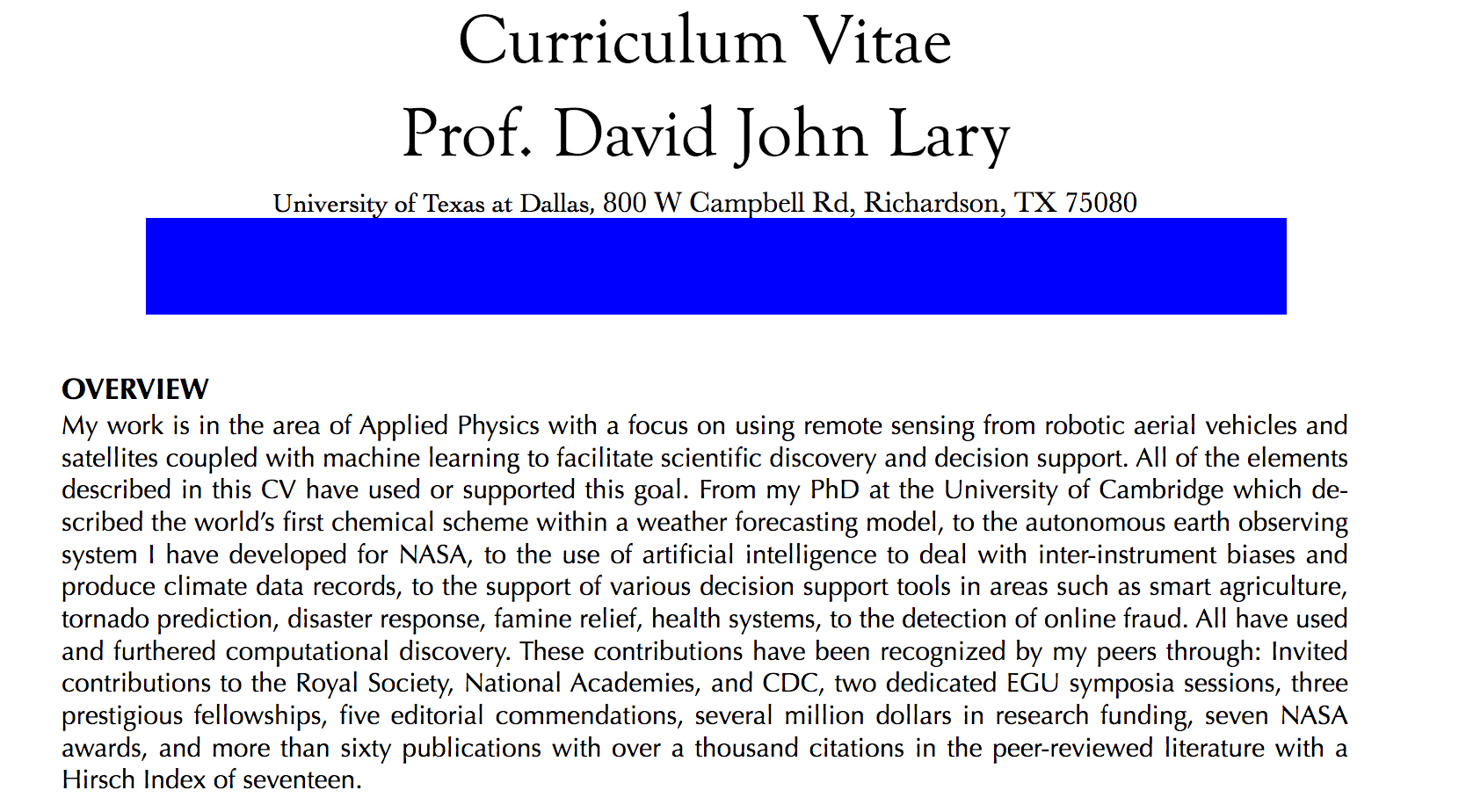 The TNC-Dallas Breathe Easy study is using the Texas A&M Transportation Institute for their air monitoring expertise. Much like the Nature Conservancy, this is a fine outfit, well-known for its work in transportation policy. It is not known for any air quality monitoring work and one can look in vain on its website for a mention of such. No one on their faculty even comes close to matching Dr. Lary’s credentials.
The TNC-Dallas Breathe Easy study is using the Texas A&M Transportation Institute for their air monitoring expertise. Much like the Nature Conservancy, this is a fine outfit, well-known for its work in transportation policy. It is not known for any air quality monitoring work and one can look in vain on its website for a mention of such. No one on their faculty even comes close to matching Dr. Lary’s credentials.
The kicker is that for the same $280,000 as Breathe Easy has raised, Dr. Lary has said he and his lab could build 200 + monitors for regional distribution. Data services will be donated by UTD. You get about 190 more monitors and real time public access for the same money.
So on the one hand you have an expensive study run by a private foundation for a short time using untested expertise, and on the other you have a cost-effective perpetual public network advised by one of the country’s leading authorities on air monitoring. You don’t have to have lived in Dallas very long to know which choice was the “no-brainer” for staff.
The Private Study and the Public Network don’t have to be mutually exclusive, but that’s the way City staff often portrays the choices to the Council – whose first exposure to any of this material will be at the scheduled August 27th Quality of Life Committee public hearing on joining the Regional Network, chaired by Council Member Sandy Greyson.
The Conservancy study could be done parallel to the establishment of the network and its school monitors folded into it at the end of the planned two-year shelf life. The city could help the Conservancy and be a part of the Network at the same time. But Staff seems to have made up their minds they can only support one air monitoring project, or rather, dug in their heels over the overly-democratic goals of this network project – it being supported by the Satanists and Dirty Hippies and all.
There’s no doubt that the same changes in technology which have disrupted other industries are disrupting environmental monitoring too. The ability to buy very reliable monitors for not much money is sending control away from top-down hierarchies to the bottom-up, crowd-sourcing rabble. A few expensive sites are being replaced by hundreds of inexpensive ones. Homeowners are already buying and installing their own consumer versions and linking to national and international networks. They’re making the status quo obsolete, one monitor at a time.
The regional network proposed by Dr. Lary and the DFW Air Research Consortium is designed to try to harness this disruption for public health’s sake. It’s open source, accepting all comers that meet its technical guidelines for participation, utilizes machine learning, and dispenses monitors where the science and need lead, no matter how many. It’s the same thing being done in Los Angeles, Baltimore, Chicago, and Chattanooga. And even Plano, which has already ordered its first monitors from UTD.
Plano has decided it wants a seat at the table as the sensor networks of the future are built. It’s participating out of self-interest because it knows otherwise, the city might not have a say in how the technology is used there. It’s the polar opposite from the sentiments Dallas OEQ staffers have expressed.
On the 27th, Council Member Greyson will be using her Committee hearing to contrast and compare the two air monitoring projects.
City staff will do one presentation on the Breathe Easy study and UTD’s Dr. Lary and Downwinders Director Jim Schermbeck will do another on the regional monitor network. 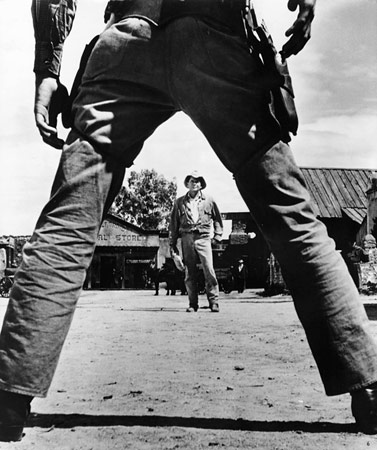
Then it will up to the Committee to decide if Dallas can be as progressive on air quality as Plano.
We’re told there will be no public comment allowed. Still, we encourage you to come down to City Hall, put on a button, buy some popcorn, and root for Democracy. The Dirty Hippies are on a roll of late.
New Grant Gives Us a Campaign Budget for 2 Years
 Downwinders at Risk is proud to announce we received a very generous $40,000 grant from the Dallas-based Simmons Sisters Fund in December to cover the costs of our “No Safe Level” PM pollution protection campaign for the next two years.
Downwinders at Risk is proud to announce we received a very generous $40,000 grant from the Dallas-based Simmons Sisters Fund in December to cover the costs of our “No Safe Level” PM pollution protection campaign for the next two years.
This money will be going to buy both portable and stationary PM pollution monitors, educational and outreach materials, including videos, websites and social media campaigns, new studies we need to advance the cause, and a host of other things we would not have even thought possible before the arrival of this grant. We can’t tell you how excited we are to have this kind of budget. We can really start to make a difference right out of the gate.
But we still need you. We need you to show-up at our monthly meetings and learn how you can plug into this campaign, which has the potential to reshape public policy in so many ways. We need you to invite us to your PTA, club, or church gatherings to present the information about PM that makes every audience gasp. And yes, we still need your donations – to pay for salaries of our one and half staffers, other projects, and special events like our Root and Branch Conference.
We just got a huge vote of confidence in our new campaign from the Simmons Sister Fund. Please consider giving your own as well. Thanks.

/cloudfront-us-east-1.images.arcpublishing.com/dmn/KAAKWCLEMNCRXNYABMHB33CEPA.jpg)
